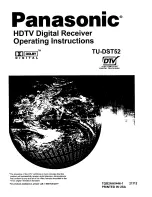
www.javad.com
9
Figure 5.
NetView: Connection via serial port
Establishing an USB connection
Make sure the computer has JAVAD GNSS’s USB
driver installed (available from www.javad.com) be
-
fore continuing.
1. Using the USB cable, connect the USB port on the
receiver to a USB port on the computer.
2. Press the power buttons on the receiver and com-
puter to turn them on.
3. Start NetView and select USB as type of connec-
tion mode and select USB port ID from the list
Figure 6.
NetView: USB connection
Configuring Receiver
Both Base and Rover receivers must be configured
according to the desired survey method.
In applications where real-time positioning results
are required, the Base receiver provides the correction
information needed to properly calculate the location
of the Rover receiver. A Base station is normally set up
over a known point and collects GPS/GLONASS data
from satellites. As the receiver picks up satellite data,
it measures the carrier and code phases to accurate-
ly compute and verify its location. Then, the receiver
transmits this information via radio (UHF or GSM) to
the Rover receiver.
The Rover receiver applies correction information
from the Base station to its current location to accu-
rately calculate one or more points. Rovers are mobile
GNSS receivers on a survey pole or bipod that com-
pares the information from the Base station to the data
it logs from satellites and applies correction algorithms
to accurately calculate a new point.
In applications intended for post-processing, the re-
ceivers typically log code phase and/or carrier phase
measurements separately from common satellites and
during the same time interval. This data is then pro-
cessed using post-processing software (for example,
Justin).
When configuring receivers for RTK surveying, use
the following list to ensure the receivers are properly
set up:
Configure one receiver as an RTK Base station and
the other receiver as an RTK Rover.
Configure the communication data link for transmit
-
ting and receiving corrections.
Set up the Base receiver over a known point to begin
collecting static observation data and transmitting cor-
rections. Set up the Rover receiver to begin collecting
RTK data.
When configuring receivers for post-processing sur
-
veying, use the following list to ensure the receivers are
properly set up:
Configure one receiver as a Base station and the oth
-
er receiver as a Rover.
Set up the Base receiver over a known point to begin
collecting static observation data. Set up the Rover re-
ceiver to begin collecting static or kinematic observa-
tion data.
Summary of Contents for DELTA-3
Page 21: ...www javad com 21 ...








































